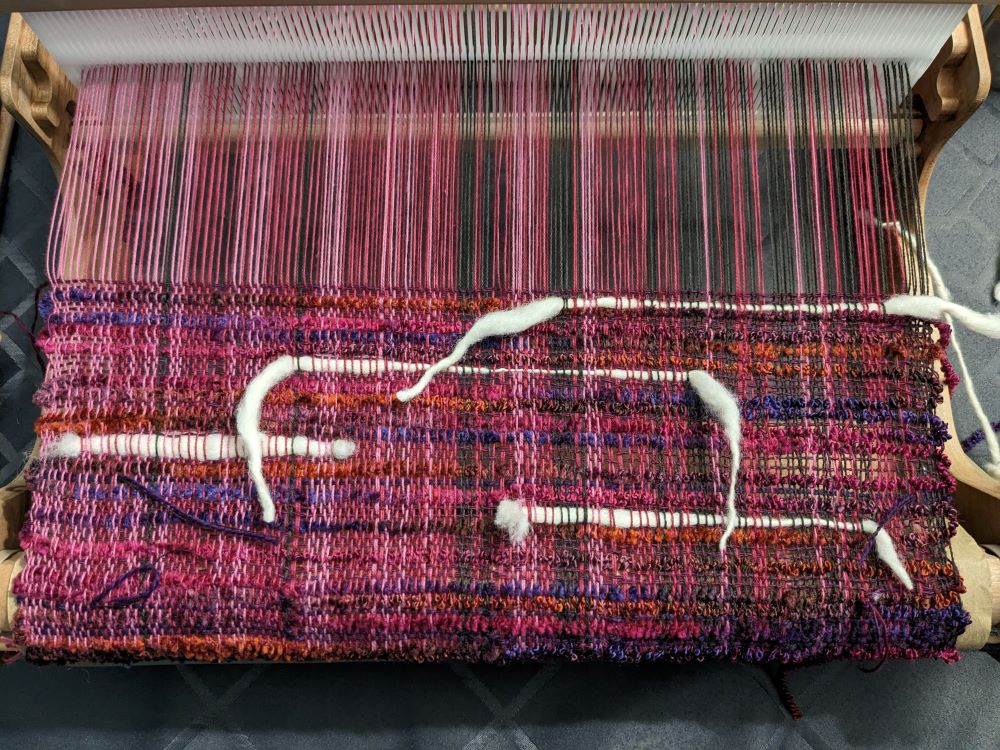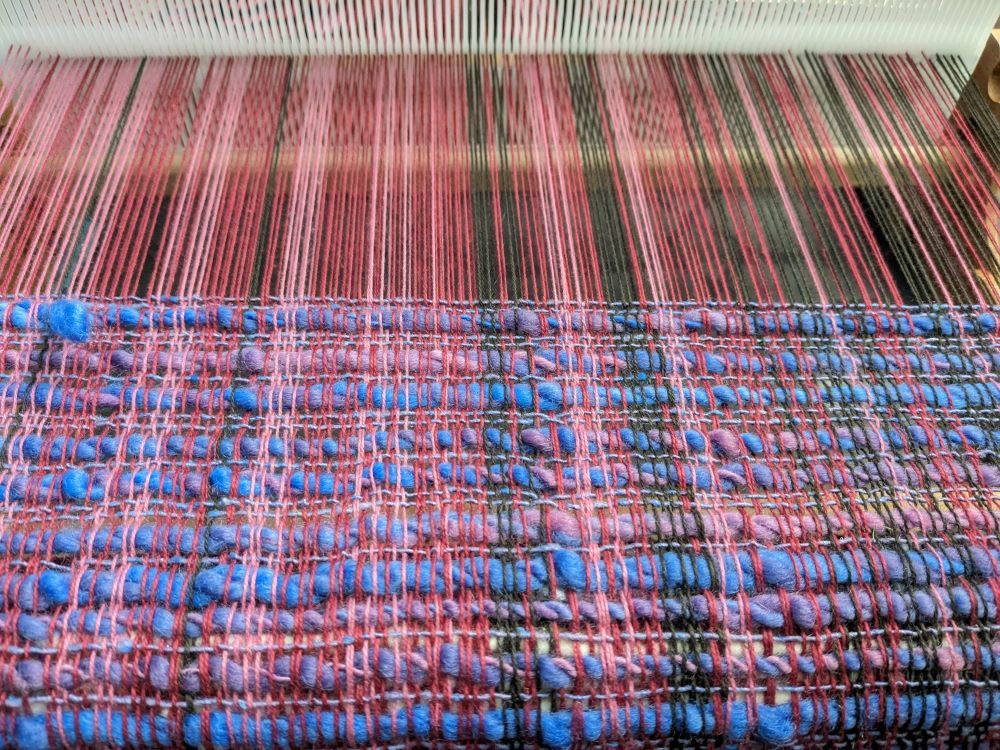What is Saori weaving, and is it something I can do on a rigid heddle loom?
project ideastechniqueSaori is a philosophy of creative expression through weaving developed by the late Misao Jo (1913-2018) in Japan. It emphasizes developing individual creativity, embracing flaws, and making fabric that a machine can’t. Saori fabrics are one of a kind pieces often exploring color and texture in fairly irregular ways.
SAORI is a trademarked brand name, and encompasses both the philosophy, the looms and other equipment, and a network of registered SAORI studios and teachers worldwide that teach this style of weaving. In this post I’m going to make a distinction and use “Saori” when talking about the general philosophy as described in sources like Misao Jo’s book SAORI: Self Innovation through Free Weaving, and “SAORI” to refer to the looms or the whole package. SAORI Global has a list of registered SAORI studios worldwide. To be clear, I'm not a SAORI instructor, just someone who likes learning about different styles of weaving!
Where a lot of weaving focuses on detailed planning, repetitive, structured patterns, color changes in regular patterns like stripes and plaids, and neat edges and an even beat, Saori throws all this out and focuses on spontaneity and embracing imperfection. One thing that comes up frequently in Jo’s book is the idea that machines are great at producing perfect fabric but only humans can make imperfect fabric. There’s no such thing as a mistake in Saori!
Saori weaving embraces the simplicity of plain weave to make fabrics that are anything but plain! Saori makes use of techniques like spontaneous color and texture changes, clasped weft, and inlay, and choosing these in the moment rather than pre-planning a design beyond perhaps things like the overall size of fabric and selecting some yarns. Saori style projects are a great way to use up small odds and ends of yarn!
Saori often uses a basic black warp as a blank canvas (as white tends to wash out colors), and this is a common setup in classes or when a loom will be used by many people, but this is by no means a requirement and you can do whatever you like with the warp! Like the weft, irregularity is encouraged! You can leave some gaps, put in some irregular stripes, mix yarns, etc.
See SAORI instructor Heather from Art Weaver Studio in Australia talking about Saori, showing off some fabrics, and teaching a newbie the basics!
SAORI looms are small 2 shaft floor looms designed to get you into the flow of weaving, and you have the option of purchasing pre-wound warps, but you can also wind the warp yourself. They have a compact 40cm (16”) version, various 60cm (24”) models, and a large 90cm (35”) model. They have a kit to extend some models to 4 shafts, but the focus of SAORI is really on the smaller, 2 shaft looms.
SAORI classes teach students the basic operation of the loom and then let the students explore and express themselves with the weaving with some hints from the instructor. SAORI fabrics often involve a lot of color and texture but the design is up to you and there are no rules!
Saori aims to be accessible to all and can be used in art therapy programs; Jo talks about the creativity of intellectually disabled weavers in her book and there are a number of accessories available for the looms to make them more accessible to various physical challenges, including one model that is wheelchair accessible.
Watch SAORI instructor Chiaki O’Brien from Studio FUN warping and weaving, and working with developmentally disabled weavers to teach SAORI weaving!
There are several SAORI weaving books, many of which include “patterns” for simple garments. I put patterns in quotes because they are more general suggestions of how to piece together fabric into garments than a typical sewing pattern with precise measurements. Some of the pattern books are only in Japanese but are highly visual with minimal text so people find them useful without a translation! These garments are influenced by Japanese kimonos, origami, and western clothing shapes, to make garments that are simple to assemble but anything but plain!
Can I practice SAORI weaving on a rigid heddle loom? #
You can certainly take the philosophy and techniques of Saori from the books or a SAORI class and weave the same kind of fabrics on a rigid heddle loom, or pretty much any loom. Like a SAORI loom, rigid heddle looms focus on plain weave and the techniques used in SAORI weaving like clasped weft and inlay are also common within rigid heddle weaving. The SAORI clothing patterns work well with the kinds of narrow fabrics you can make on a rigid heddle loom. I have seen one thing done on a SAORI loom that a rigid heddle loom couldn’t do - the top of the reed was able to open and the weaver lifted up and twisted around a few warp threads; but this was a special 'comb' reed. A SAORI loom is also going to be more flexible with cramming and spacing a warp and using very different thicknesses of warp; if that sort of weaving interests you, you can take a look at the variable dent heddles available for many models of rigid heddle loom.

However, note that SAORI is a trademarked brand name. To use the SAORI name to teach a class, you must be a certified instructor, use SAORI equipment, and otherwise follow the requirements of SAORI Global, likewise there are requirements if you wish to sell completed items using the SAORI name. So you will see other terms like “freestyle weaving” or “freeform weaving”, by people teaching similar techniques without the whole package, or “Saori style” or “Saori inspired” to describe a project.
Rigid heddle looms are much cheaper than the SAORI looms, and there may not be a SAORI studio nearby, so for many that makes them a more affordable way of embracing the philosophy of Saori, but it's not quite the same experience as a SAORI loom.
Advantages of a SAORI loom over a rigid heddle loom #
The SAORI looms are designed around keeping things simple, getting you into the flow of weaving plain weave. and being comfortable to use. They are floor looms and so are controlled with foot treadles; some people find the full body experience of using foot treadles and throwing a boat shuttle gets them into a better flow. They come with built-in bobbin winders and a shelf to make frequent color changes with a boat shuttle easy. They are also designed to accommodate much longer warps than a rigid heddle loom, and you can purchase pre wound warps which greatly simplifies the setup process if you enjoy the weaving more than warping.

I’d love to take a proper SAORI class some day, but there aren’t any studios nearby. My current project is Saori inspired and it is interesting to play with texture and it’s been great for playing with my very beginner handspun yarns! I put on a warp with a random gradient using a light pink, medium pink, and a brown, with some gaps in it, and am using up yarns from my guild’s summer challenge mystery bag and some of my beginner, highly textured, hand spun and other odds and ends. I also enjoy the more “left brained” aspects of more traditional weaving and pre-planning projects (after all, I’ve been building design software for rigid heddle weavers!), but it’s been fun to mix things up for a project!
Some SAORI and Saori inspired Resources #
-
CuriousWeaver is a SAORI instructor in Australia who has a great blog with some tips on Saori clothing.
-
Schacht's Blog on weaving a Saori inspired scarf on the Cricket loom
-
Saori Santa Cruz is both a SAORI studio and an Ashford dealer. Jill is active in both Saori and rigid heddle groups on Ravelry.
- Next: So what can’t a rigid heddle loom do?
- Previous: Ravelry for Weavers
Check out Not So Rigid Designer, the online weaving software for rigid heddle loom weavers!
